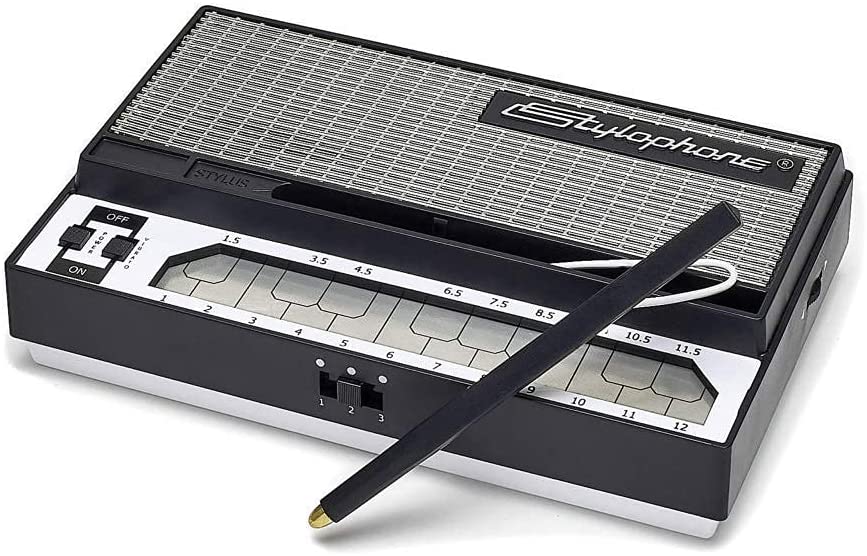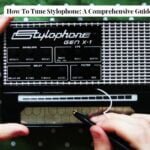The Stylophone is a small, handheld electronic keyboard that was first released in 1963. It is a popular choice for musicians and producers because of its unique sound and portability. The Stylophone can be used to create a variety of sounds, from simple melodies to complex textures.
What Is Stylophone
- Miniaturized Music Machine: Invented in the 1960s, it’s a super compact electronic keyboard that runs on batteries. You can take it anywhere and make music on the go!
- Stylus Superstar: Instead of pressing keys, you play the Stylophone by touching a metal fretboard with a stylus, kind of like a mini touch screen.
- Electronic Vibes: It’s considered a monophonic instrument, meaning it plays one note at a time. But what it lacks in complexity, it makes up for in its cool electronic sounds. You can bend these sounds with built-in controls for vibrato and filter, adding an extra layer of trippy effects.
- Classic with a Modern Edge: The Stylophone became a huge hit in the late 60s, selling millions thanks to its affordability, portability, and just plain coolness. It’s considered a classic novelty instrument and has even been used by famous musicians like David Bowie. These days, the Stylophone company still makes them, and even offers updated versions with features like built-in delays and jacks for connecting to other instruments, making them more versatile than ever.
Effects pedals
Effects pedals are devices that can be used to alter the sound of an instrument. There are a wide variety of effects pedals available, each with its own unique sound. Some popular effects pedals include distortion pedals, delay pedals, and reverb pedals.
Combining the Stylophone and effects pedals
The Stylophone can be used with effects pedals to create a variety of new sonic possibilities. For example, a distortion pedal can be used to create a more aggressive sound, while a delay pedal can be used to create a more atmospheric sound.
How do I choose the right effects pedals for my Stylophone?
The best way to choose the right effects pedals for your Stylophone is to experiment with different pedals and see what sounds you like. Some factors to consider when choosing effects pedals include the type of sound you want to create, the price of the pedals, and the size of the pedals.

What are some popular effects pedals to use with the Stylophone?
Some popular effects pedals to use with the Stylophone include:
- Distortion pedals: Distortion pedals can be used to create a more aggressive sound.
- Delay pedals: Delay pedals can be used to create a more atmospheric sound.
- Reverb pedals: Reverb pedals can be used to create a more spacious sound.
How do I connect my Stylophone to effects pedals?
There are a few different ways to connect your Stylophone to effects pedals. One way is to use a 3.5mm audio cable. Another way is to use a MIDI cable.
What are some tips for using effects pedals with the Stylophone?
Here are some tips for using effects pedals with the Stylophone:
- Start with a clean sound and then add effects pedals one at a time.
- Experiment with different settings on the effects pedals to see what sounds you like.
- Don’t be afraid to use multiple effects pedals at the same time.
What are some examples of artists who have used the Stylophone and effects pedals?
Some examples of artists who have used the Stylophone and effects pedals include:
- Kraftwerk
- The Chemical Brothers
- Aphex Twin
- Boards of Canada
- Animal Collective
The Synergy: Stylophone and Effects Pedals
When the Stylophone is paired with effects pedals, it can produce a wide range of sonic textures and tones. The combination allows musicians to experiment with different effects and manipulate the instrument’s sound in real-time. By utilizing pedals such as delay, reverb, and distortion, the Stylophone’s relatively simple sound can be transformed into something much more complex and rich. This synergy opens the door to new musical genres, from ambient and experimental to rock and electronic.

Popular Effects Pedals for Stylophone
- Delay Pedals: Delay pedals create echoes and repeats of the original sound, adding depth and space to the Stylophone’s notes. This effect can be used subtly to create a sense of space or pushed to the extreme for more experimental and psychedelic sounds.
- Reverb Pedals: Reverb pedals simulate the natural reverberation that occurs in different environments. By adding reverb to the Stylophone’s sound, musicians can create an illusion of playing in various acoustic spaces, from small rooms to large cathedrals.
- Distortion Pedals: Distortion pedals are often associated with electric guitars, but when applied to the Stylophone, they can add grit, sustain, and a raw edge to the sound. This can be particularly useful for creating distorted leads or adding intensity to a performance.
- Modulation Pedals: Modulation pedals, such as chorus, phaser, and flanger, manipulate the Stylophone’s sound by altering its pitch, frequency, or amplitude. These effects can create swirling, pulsating, or sweeping textures that add movement and character to the instrument’s sound.
Does a Stylophone need an amp?
No, a Stylophone does not necessarily require an amplifier. The device itself has a built-in speaker, allowing you to play it without any additional equipment. However, if you wish to amplify the sound or connect it to external devices, such as effects pedals or recording equipment, you can use an amp or audio interface for better sound quality and versatility.
How does the Stylophone produce sound?
The Stylophone produces sound through a simple electronic circuit. When the conductive strips on the metal keyboard are touched by the stylus, a connection is made, allowing an electric current to flow through the circuit. This current is then converted into audible sound waves by a small built-in speaker or can be connected to external audio devices for amplification and further manipulation.

Is Stylophone hard to play?
The Stylophone is generally considered to be an accessible instrument, suitable for beginners and experienced musicians alike. Its small size and simplified keyboard layout make it easy to start playing basic melodies and experimenting with different sounds. However, mastering more advanced techniques and playing complex compositions may require practice and familiarity with the instrument’s nuances.
Can you connect the Stylophone to a PC?
Yes, it is possible to connect a Stylophone to a PC. One common method is by using a 1/4″ to 3.5mm adapter cable to connect the Stylophone’s audio output to the PC’s line-in or microphone input. This allows you to record the Stylophone’s sound directly onto your computer or use it with music production software for further processing and integration into your compositions.
Stylophone with TREMOLO sounds kinda NOSTALGIC
FAQs
What are some of the limitations of the Stylophone?
The Stylophone has a few limitations, including:
– It has a limited range of notes.
– It can be difficult to play in tune.
– It is not very loud.
What are some of the benefits of using the Stylophone?
The Stylophone has a few benefits, including:
– It is very portable.
– It is relatively inexpensive.
– It is easy to learn how to play.
– It has a unique sound.
Conclusion
The Stylophone is a fun and versatile instrument that can be used to create a variety of sounds. When combined with effects pedals, the Stylophone can be used to create even more possibilities. If you are looking for a unique and portable instrument to add to your collection, the Stylophone is a great option.


